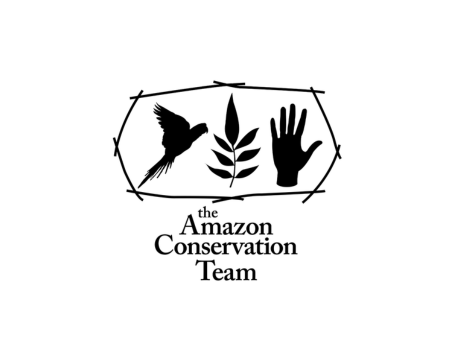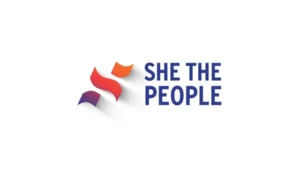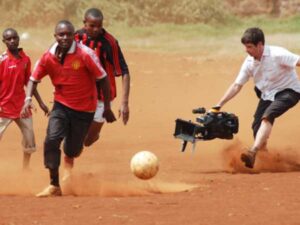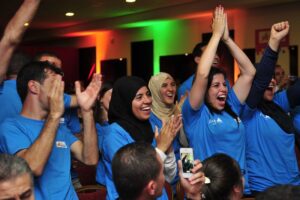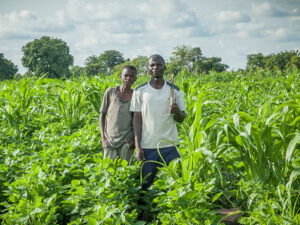Amazon Conservation Team is a non-profit organization that works in partnership with indigenous people of tropical South America in conserving the biodiversity of the Amazon rainforest, as well as the culture and land of its indigenous people.
Minu Parahoe of Amazon Conservation Team spoke with Ambika Samarthya-Howard on June 5, 2025. Click here to read the full conversation with insights highlighted.
Ambika Samarthya-Howard: Can you start by introducing yourself and the work you do?
Minu Parahoe: My name is Minu Parahoe, and I’m Regional Director of Amazon Conservation Team Guianas, stationed in Suriname. ACT works in the Southeast Amazon (Brazil), Northeast Amazon (Suriname) and Northwest Amazon (Colombia). Beyond the Amazon we focus on the Guiana Shield region and coastal areas. We work directly with indigenous, tribal, and local communities, and we do advocacy to get legislation in place that would facilitate the work that these communities have been doing. We are strengthening and equipping the communities in their efforts to conserve their forests and territories.
For example, collective rights have not been recognized yet for the indigenous and the Maroons in Suriname. Maroons are the descendants of escaped slaves. They are the Afro-descendants living in the interior of Suriname, and they have an established community, just like the Amerindians. In Suriname, we recognise them as Indigenous and tribal communities. The indigenous want to be mentioned. We know that indigenous are tribal, but we still talk about indigenous and tribal or indigenous and Maroons.
We have two distinct groups predominantly living in the interior. Their rights have not been recognized. We are the only country on this continent that has not been able to recognize such rights as of yet.
Ambika Samarthya-Howard: Why do you think that is?
Minu Parahoe: I think it’s partly because of political unwillingness, and partly due to limited capacity to implement those rights and create legislation with community involvement.
Ambika Samarthya-Howard: What’s an advantage to the government not to recognize it?
Minu Parahoe: If you look at the economic activities that have been established over the past decade by outsiders and city dwellers, rather than the actual people living in these interior areas, there are economic risks and concerns about giving more rights to indigenous people and tribal people. Economic gains may be impacted. The other reason is that concessions have already been issued, so you may get lawsuits. Those are the fears.
In the legislation that was drafted with our support, and that we facilitated by paying for experts and legal advisors, indigenous and tribal people expressed their wishes. A draft was made and submitted to Parliament in 2023. It showed that all of those fears can be dealt with if you consider a phase-out.
Not immediately, because the government created the situation. Therefore, you cannot punish the private sector and the indigenous. You need to find a middle ground. However, political willingness was not there. The act was not approved. Instead of discussing the act and improving it, a new version was submitted earlier this year without us, which was really a disgrace.
Ambika Samarthya-Howard: Who submitted it?
Minu Parahoe: Only a few people worked on it. It was not approved. Now we have a new government coming in that will consist of six coalition parties, which makes it hard to get a very straight, clear understanding of the policy regarding the interior of Suriname. We are more than 90% forested. It’s a shame to see that six parties have different ideas about that.
Suriname’s government has not been able to approve the Collective Rights Act. They have not been able to support decentralization. That’s my concern with politics. As soon as the new parties are in administration formally, we will go to meet with them to discuss our program and try to find some middle ground on which we can work together.
Ambika Samarthya-Howard: Can you tell me a little bit more about what you mean when you say “concessions”?
Minu Parahoe: In Suriname, you need licenses to [engage in certain business]. First is your exploration license. That is when you assess the feasibility of say mining, or logging, or tourism, or agriculture. After the exploration phase, there are concessions that are given so licenses can be issued for mining, for logging, and for large-scale agriculture. All of those impact the livelihoods of the people and our partners.
Ambika Samarthya-Howard: Can you talk a bit about your mapping project, your storytelling project, and how you work with the indigenous communities to connect all of that?
Minu Parahoe: We talk about map, manage, and protect. First, how do we work with the communities? We are always invited by the community, or if we are interested in a certain community, we ensure that we have some allies there who invite us. We always start by partnering with the community on invitation. In our approach towards the community and decision-making among the community, we acknowledge free, prior and informed consent guidelines.We get to know them, build trust, and then from there identify what the needs are and how they align with our own ambitions and program.
At ACT, we don’t believe in doing a one-time project. We do programs. That means we connect to what the people are envisioning around how to develop or improve their communities. We try to integrate that with our strengths, with what we have already learned somewhere else, and with what we have been working on. Then, together, we make it tailor-made for that community.
If a community doesn’t have a plan, we start by developing the life plan or plan de vida. That requires a process of mapping. We need to know the environment, the resources they need most urgently, the resources they want to protect, and the resources they want to utilize for income generation. We support them in writing their own stories to explain where they are coming from and where they are heading. Generally, that is all orally communicated. It is sufficient material to capture the history linked to the geographic location.
That is where the program organically develops from heritage. We help these communities preserve immaterial heritage and cultural knowledge. Then we link that to a geographic location. We build our maps from the community’s story of where they are, where they are heading, what they are losing, what they want to keep, and so on.
Ambika Samarthya-Howard: Can you give an example of work you’re doing now that connects storytelling with livelihoods or landrights? Or is there a success you’ve had in the past with shifting societal attitudes through storytelling? How do you monitor success in terms of societal and cultural impact?
Minu Parahoe: In some countries where you are able to establish a reserve, an Amerindian reserve, you can show the progress. In our case, we don’t even have rights recognized, let alone getting a formal reserve or territory demarcated. So this can be tedious for us.
For instance, we started with mapping, and then over the years, we got the request to help communities with setting up clinics or infrastructure where the local knowledgeables had their own place to transfer medicinal knowledge to the younger generation. This is tricky because the work is happening in their language, so we often don’t know what they’re talking about. Without the language, we don’t know the details. We don’t even know if they’re really transferring the knowledge.
Intellectual property rights are not regulated in Suriname, so we can’t even begin to enter the area of trying to understand it. Today we have the fourth generation engaged in the clinics, which means that somebody started doing it in the 80s. In the 90s, a nephew started doing it, then his son was doing it, and now a grandson is doing it. We are mapping the fourth generation [of knowledge].
I think the story is that people have started to value their knowledge, which wasn’t always the case back in the day, because they were very Christianized.
During the COVID pandemic, it was a must for survival to look at the resources they had at hand. We had a very peculiar development where people in one village started to voluntarily visit traditional clinics to get their daily shots of traditional medicines. In that sense, you see appreciation as people are continuing the work. Analagous to the success story of that village, we have been seeing more requests coming from different communities asking us to help them set up a clinic. That is a story that has been told, those are observations made by other communities, and those are the exchanges that we facilitate.
Since the WHO [World Health Organization] established earlier this year that they are more into supporting integrative health systems in India, we see that Western governments have designed Integrative Health System Acts. We had our first collective congress this year, and they’re willing to work with us to equip local communities in getting ready for when this act is approved and implemented, so they can also benefit from it.
That’s how we work underground, at a grassroots level with communities. We try to bring their concerns, needs, and ambitions to the national level and support the government in the process of developing legislation.
Ambika Samarthya-Howard: It’s incredibly impressive that you’re able to plot this intergenerationally, but what about when you’re working on grants or projects that go on for six months or a year? How do you showcase what you want to achieve in a shorter-term period, specifically with the mapping projects? How do you showcase to a funder? What are you going to do with the mapping project when somebody asks you?
Minu Parahoe: In a year-long project, we could do some mapping with a community. We could showcase the resources needed to maintain the community’s culture and identity, and how to ensure the community has continued access to those resources. Secondly, we zone the area. This is to potentially negotiate future contributions to the 30 by 30. We want to be part of a national policy of getting to 30 by 30.
Ambika Samarthya-Howard: Would the maps be part of that?
Minu Parahoe: Yes. The maps could be where the community emphasizes, this is what we need to survive and maintain our identity.
Mapping our sacred places is also very important because we believe there is a flow of resources and species that need to have movement. About five years ago, we worked with a community that said, when the mapping was done: this is ours. We know it. Our ancestors lived there. We have old villages there. This is something that could become a protected area in the future, but the precondition is that our collective rights need to be recognized. That is something for the future.
Within the project, we emphasize the importance of zoning, the importance of how communities envision their future, how they contribute to the national conservation policy, and so on. In addition, we have seen that communities are now more than ever interested in utilizing resources for the new buzzword “community bio businesses.” Communities also want their kids to get more than just a primary education. Funding income revenues has become important. That is the reality.
When you map, you also determine the local species. What species are known by the locals? What species have a potential added value that can be transformed? It is not easy because there is no 24/7 electricity or water access, and it is very expensive to travel.
Ambika Samarthya-Howard: When you started in 1996, a lot of people didn’t feel like it made sense to listen to indigenous populations, and you faced much rejection. Now, everybody in the funder’s world is listening to indigenous populations. What do you think shifted that attitude in philanthropy, and also in governments and communities?
Minu Parahoe: I think the conventional way of conservation approaches, like species-oriented approaches, failed. As organizations, we’re finally understanding that people are part of the ecosystem. If you don’t address their needs and their challenges, how will you start talking about conservation, and why protect this or that? The people’s approach has become a necessity.
Ambika Samarthya-Howard: How do you handle the challenges of working with indigenous communities, such as working in situations where you don’t know the language? How do you shift your own beliefs? What do you think has made you successful in your partnerships?
Minu Parahoe: It’s all about trust. Building trust is so important. How do you build trust? You cannot just come into a village, stay one night, do your thing, and move out. You need to do more than just your project activities. Stay with them, eat with them, work with them, give them time. Trust building is very important.
Another thing I would say is don’t rush. When dealing with the donors, the philanthropy, the people who fund the work, you are often dealing with a Western attitude. You have a project with a timeline and a budget, and you’re promising that you will deliver X, Y, and Z. But you also have the reality of the community. You want to have the best of both worlds.
You cannot go into a community and just discuss these important deadlines you need to meet. You need to connect to the human side of the work, to be open to what’s happening in the community and adjust. For instance, at ACT we say we’re all about strengthening governance cultures and protecting the Amazon. We have a joke here in the office that we are a social organization because when somebody dies, a corpse needs to be transported. Where do they get the funding from? No one wants to talk about it, but we do contribute to it because sick people come to the city and vice versa. I see corpses.
People know that they can come to you, but we don’t want to make them dependent on us. That’s why whenever we strengthen the communities or parts of our rangers program, we try to give people more responsibility. That’s a process, but we need to have our exit strategy in place in a few years, at least for one or two communities, and gradually extract.
Ambika Samarthya-Howard: Is there anything related to what you might call indigenous mindsets that you feel we haven’t implemented yet? What are some things we are not doing? How could we be thinking differently, and what would you like to see happen in this space?
Minu Parahoe: I would like to see more self-determination. We are seeing that in the villages, but although we developed a plan together, a development plan, and we have the maps, the decentralization is not yet formalized. The next step is to equip the leadership to negotiate based on the plans, the same way they negotiate with the government in investing, or with the private sector, or with NGOs in the community.
I would like to see the transition to no longer falling back into requests of, can you help me with this? No, you have a plan, and you have a vision. We are in the process of training communities. We’ve trained five communities this year, giving them the tools they need for this self-determination, but we need to monitor and guide them because we want them to grow to another level of negotiation, not to fall back into the culture of asking. We want them to grow into that place of independence.
Ambika Samarthya-Howard: What are some indigenous values that you feel we can do a better job of promoting?
Minu Parahoe: The ability to take care of your community. Over the years, there has been adaptation for survival. We are not fully recognizing how little support these communities have been getting from the national government administration, yet still, they exist. They’re resilient. COVID came from the outside. Almost every year they have flooding and droughts. Their resilience is a tremendous strength. We are always talking about challenges, but they have incredible strengths.
Ambika Samarthya-Howard: How do you enter coalitions, what coalitions are you part of, and what role does ACT play?
Minu Parahoe: We’ve worked with PIACI [Protection of Indigenous Peoples in Voluntary Isolation and Initial Contact] for a few years. They’re quite big in the Amazon region, connecting many organizations of the Amazon. ACT is part of that network, and has been the secretariat for about one year. We are trying to find PIACI in Suriname to explore uncontacted tribes there.
Then, not directly but through our local ally OIS [Organization of Indigenous in Suriname], we have some links with COICA [Coordinator of Indigenous Organizations of the Amazon River Basin]. COICA has some internal struggles, so we have been a little bit hesitant there.
We are also part of different mapping platforms. That is mainly nurtured by our colleague in the US because the GIS [geographic information section] is well established there. We also just joined a coalition on bioeconomics that is basically nurtured by Colombia and Brazil.
Ambika Samarthya-Howard: Who is in that coalition?
Minu Parahoe: Conexsus and all the partners of Conexsus in six countries. We are one of the newcomers. There is also the Rangers Federation, where we would like to get more engaged now that we were formally trained and certified by the government. Then there is the social platform. When we want to advocate on topics like indigenous rights, our colleagues in Colombia are very strong. Often, the Brazilians take the lead, and we join them. We provide the content and explain our situation because it’s different from theirs.
Ambika Samarthya-Howard: What inspired your bio-economies coalition with Conexus? Is it so you can share resources?
Minu Parahoe: It’s mainly because we can learn from them. The biggest problem we have as a small economy and a small population is marketing. We cannot sell locally, and our scale is too small to enter export markets. We have a lot of hurdles. We try to learn. It’s a learning experience, the opportunity to see what the best practices are, more than a financial motivation.
Ambika Samarthya-Howard: When you look back at the history of ACT, if you had known then what you know now, what would you have done differently? What are some mistakes you made? What’s some advice you’d give to other organizations?
Minu Parahoe: We should have made it mandatory for our staff in the field to know the language of the communities. We know it, but we don’t know it well. We have seen how the church did that, and they did a great job first learning the language and growing from there. We have a great relationship, but the language is something that we should be improving because FPIC [free, prior, and informed consent] requires you to ensure that people understand you. Even when we speak their language, because we are outsiders, we need to work with interpreters. There are a lot of misunderstandings. When you know the language, you could solve that in a very early stage, rather than having conflicts arise from poor communication.
Another mistake we have made is not trying sufficiently enough to mend relationships when we have experienced challenges with certain organizations. After a few attempts at mending them, we went back to doing what we always did, continuing with our program in the same way. I think that in an earlier stage, we could have tried to mend some of those relationships.
Since education is at a very low level in the interior of Suriname, because teachers don’t want to go and stay, I think we should have invested more in education.
Ambika Samarthya-Howard: How would you have done that?
Minu Parahoe: We should have gotten additional funding for teachers that we already had there, given them incentives or gotten somebody in the village that speaks Dutch to give incentives. Maybe have a program in the afternoon to get people to learn how to speak, write, and read Dutch. We see direct setbacks if the communities cannot speak the language correctly. It’s a big obstacle we encounter when we train them.
In addition, we have been talking with the government about establishing intercultural education, where the local language and Dutch are combined in the formal schools. However, we can start by first showing extra support from ACT by supporting five or six people in the village in really learning Dutch, then another five the next year, and the next year another five, so just to get things rolling. The minister of education, who will be replaced shortly, said that he was in favor of introducing bilingual education in primary school. Those are some things we perhaps should have been more aggressive on.
Ambika Samarthya-Howard: That’s hard because so much of what you’re doing is respecting the traditions, languages, and culture of indigenous populations.
Minu Parahoe: That is exactly the reason why we have not been doing it. But it’s tough because at the same time, the people want to have more self-determination and to be recognized. We see the obstacles. We want to do something, but we keep asking: what will the impact be? We don’t want a situation where people will no longer speak the traditional language. It’s tricky.
Ambika Samarthya-Howard: What’s on your radar for COP [Conference of the Parties] in the next year, and for the next five years? What’s next for you?
Minu Parahoe: We are developing a program where all the ACT countries will work together on something called One Health, looking at the health of the people, learning from each other and trying to improve with that knowledge, and looking at the health of people’s surroundings, their immediate livelihoods and their immediate environment.
From there, we are going to present a few things at COP30. One is Food Atlas. Food Atlas was created in Colombia and was a very big success when it was presented during COP last year.
We will be going into selected communities in different countries and mapping the resources that they have been cultivating for many years, but that are eroding and diminishing. We will map those before they run out of time and create a recipe book of authentic recipes that explains how they have contributed to nutrition.
From there, the next step will be to help them with gene banks to see if they can revive and restore those resources that are still important to them, but that they’re losing. We will be working on a program around that in the coming years. Then we have territorial rights, which remain important, especially for us to get recognition. We will have to see what happens. We’re learning from the region.
In Guyana, where we also work, we have a community of Wai-wais. Their land title rights are already recognized. They have rangers, they’re managing their own lands, and they have their own plans. We’re working with them to learn how we can communicate that specific example to our authorities here. We also continue to look at PIACI. We will be trained this year by our colleagues and see how we progress on that.
Apart from that, we continue to negotiate with the government. We reached a very interesting point where the government acknowledged that the rangers program we established in 2007 still exists. We have 45 indigenous rangers and tribal rangers that are trained in monitoring biodiversity and water quality, operating a drone, mapping, and so on. They will be used as a model to build a national ranger system because the government acknowledges that they are no longer able to manage protected areas and areas where these communities live.
They finally started to be open to the idea of elevating the system from a proven working model to a national system, where we could become one of the partners. This is something that we discussed last month, and for which a budget was made and plans established to set up and fundraise for an endowment fund in order to have that already allocated. We will have to go back to this new government and see whether they’re still in favor.
Ambika Samarthya-Howard: How does ACT work across countries? How do you work as a regional director, and also with the Colombia team, the Peru team, and the Brazil team?
Minu Parahoe: I’m only responsible for the Guyana program, the Suriname program, and what we do in French Guiana. Across the Amazon, we have programs and teams where different countries are engaged, and we have a focal person for each team. The focal person is different from the country’s point person, as every focal person leads on a topic. For instance, for PIACI, we have a colleague from Colombia who is a specialist in [uncontacted tribes]. All the countries of ACT, and all the other ACT offices, must invest in a colleague to be a focal person who has interest in getting to know more specifics about their topic. When all these focal people come together, they can discuss a topic across the region.
Ambika Samarthya-Howard: Does the Colombia office just manage the Colombia work?
Minu Parahoe: Yes. The Colombia office is very big. They have an executive director, and they have five other directors. They manage the work of Colombia along with Peru, and across a few countries because the indigenous move across the borders. That’s the idea. We’re trying to follow what’s happening with our communities.
For example, we have a program in Guyana, one in Suriname, and one in French Guiana. I have my staff here in Suriname, and I have staff in Guyana. We have two offices. We work together with indigenous emeralds. The indigenous of Guyana go across the border to Brazil to learn and share, and they’ve been doing that since before we were there. The same is happening in Suriname with Brazil.
We support some of the projects in Brazil, and we transfer that money to our colleague, the director of ACT Brazil. We participate together in the field in areas just across the border, not in Brasilia or in Amapá, but just across the border. The indigenous peoples of our partners also move there.
Ambika Samarthya-Howard: You have groups that cross over different borders, amongst different regions. In addition, you have focal point colleagues that are really focused on these topics. Is there an overlap between the regional and the focal?
Minu Parahoe: The focal people can only be specialists on the topic; they have no decision-making power. Otherwise, we would have chaos. For instance, my colleague from Colombia is coming with experts to Suriname to train us on PIACI. He and my staff will collaborate and set up a meeting. However, I will have to sign off on all the different things that needs to be done and what we approve.
Ambika Samarthya-Howard: You’re holding a lot of pieces. This has been fascinating. Thank you so much for your time and your insights.
Click here to read the full conversation with insights highlighted.
Ambika Samarthya-Howard (she/her) is the Solutions Journalism Network’s Chief Innovation Officer: She leads on innovation and technology, leverages communication platforms for the network strategy and creates cool content. She has an MFA from Columbia’s Film School and has been creating, teaching and writing at the intersection of storytelling and social good for two decades. She has produced content for Current TV, UNICEF, Havas, Praekelt.org, UNICEF, UNFPA, Save the Children, FCDO, Global Integrity and Prism.
* This interview has been edited and condensed.
Read about other social innovators.

